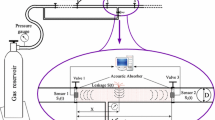Abstract
This paper presents a new method for detecting the impact location in a buried gas duct. Gas leakage is often caused by the mechanical impact forces of construction equipment. In order to prevent gas leakage due to an impact force, it is necessary to detect the impact location at an early stage. For the detection of the impact location in a pipeline system, the correlation method has been used as the conventional method. For the application of the correlation method, the diameter of a duct should be small so that the acoustic wave inside the duct can propagate with non-dispersive characteristics, in the form of, for example, a plane wave. However, when the diameter of the duct is large, the acoustic waves inside the duct propagate with dispersive characteristics owing to the reflection of the acoustic wave off of the wall of the duct. This dispersive characteristic is related to the acoustic modes inside a duct. Therefore, the correlation method does not work correctly for the detection of the impact location. This paper proposes new methods of accurately measuring the arrival time delay between two sensors attached to duct line system. This method is based on the time-frequency analyses of the short time Fourier transform (STFT) and continuous wavelet transform (CWT). These methods can discriminate direct waves (non-dispersive waves) and reflective waves (dispersive waves) from the measured wave signals through the time-frequency analysis. The direct wave or the reflective wave is used to estimate the arrival time delay. This delay is used for the identification of the impact location. This systematic method can predict the impact location due to the impact forces of construction equipment with more accuracy than the correlation method.

















Similar content being viewed by others
References
Muggleton JM, Brennan MJ (2004) Leak noise propagation and attenuation in submerged plastic water pipes. J Sound Vib 278:527–537
Fuchs HV, Riehle R (1991) Ten years of experience with leak detection by acoustic signal analysis. Appl Acoust 33:1–19
Chu WT (1999) Acoustical characteristics of leak signals in plastic water distribution pipes. Appl Acoust 58:235–254
Beck SBM, Curren MD, Sims ND, Stanway R (2005) Pipeline network features and leak detection by cross-correlation analysis of reflected waves. J Hydraul Eng 131:715–723
Munjal ML (1987) Acoustics of ducts and mufflers with application to exhaust and ventilation system design. Wiley, New York
Kinsler LE et al (1999) Fundamentals of acoustics. Wiley, New York
Eriksson LJ (1980) Higher order mode effects in circular ducts and expansion chambers. J Acoust Soc Am 68:545–550
Mason V (1969) Some experiments on the propagation of sound along a cylindrical duct containing flowing air. J Sound Vib 10:208–226
Shin K, Hammond JK (2008) Fundamentals of signal processing for sound and vibration engineers. Wiley, London
Lee SK, White R (1997) Fault diagnosis of rotating machinery using wigner higher order moment spectra. Mech Syst Signal Process 11:637–650
Lee SK, Banerjee S, Mal A (2007) Identification of impact force on a thick plate based on the elastodynamics and higher-order time-frequency analysis. Proc Inst Mech Eng C J Mech Eng Sci 221:1249–1263
Lee SK (2002) An acoustic decay measurement based on time-frequency analysis using wavelet transform. J Sound Vib 252:141–152
Teolis A (1999) Computational signal processing with wavelets. Birkhäuser, Boston
Mallat S (1999) A wavelet tour of signal processing. Academic, New York
Rao RM, Bopardikar AS (1998) Wavelet transforms introduction to theory and applications. Prentice Hall, New York
Önsay T, Haddow AG (1994) Wavelet transform analysis of transient wave propagation in a dispersive medium. J Acoust Soc Am 95:1441–1449
Newland DE (1994) An introduction to random vibrations, spectral & wavelet analysis. Longman Scientific & Technical, London
Lee SK, White PR (1998) The enhancement of impulsive noise and vibration signals for fault detection in rotating and reciprocating machinery. J Sound Vib 217:485–505
Lee SK, White PR (2000) Application of wavelet analysis to the impact harshness of a vehicle. Proc Inst Mech Eng J Mech Eng Sci C 214:1331–1338
Kim MS, Lee SK, Jang YJ, Koh JP (2008) Acoustic wave propagation characteristics corresponding to the cut-off frequency in gas pipeline. J Kor Soc Noise Vib Eng 18:693–700
Burstein L, Ingman D, Michlin Y (1999) Correlation between gas molecular weight, heating value and sonic speed under variable compositions of natural gas. ISA Trans 38:347–359
Acknowledgment
This work was supported by Mid-career Researcher Program through NRF grant funded by the MEST (No.2010-0014260).
Author information
Authors and Affiliations
Corresponding author
Rights and permissions
About this article
Cite this article
Kim, EY., Kim, MS. & Lee, SK. Identification of the Impact Location in a Gas Duct System Based on Acoustic Wave Theory and the Time Frequency. Exp Mech 51, 947–958 (2011). https://doi.org/10.1007/s11340-010-9382-y
Received:
Accepted:
Published:
Issue Date:
DOI: https://doi.org/10.1007/s11340-010-9382-y




